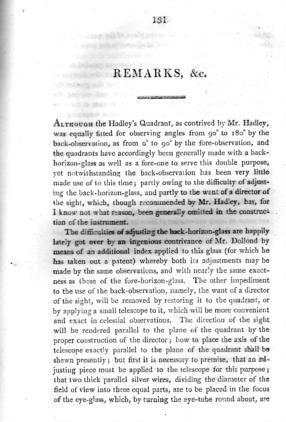
NavList:
A Community Devoted to the Preservation and Practice of Celestial Navigation and Other Methods of Traditional Wayfinding
Re: Back sights.
From: George Huxtable
Date: 2010 Mar 21, 22:25 -0000
From: George Huxtable
Date: 2010 Mar 21, 22:25 -0000
Frank Reed commented on my statement- "The original purpose of the backsight, in which the horizon was viewed in the opposite direction (and was never, as far as I know, used with a telescope) was to allow a lunar, greater than 90º, to be measured with an octant." I've never heard that before, and considering the great difficulty in getting an index correction for the back sight, which you described very clearly, it seems unlikely. So do you have a source for this? Do you remember where you encountered this idea that back sights were originally for lunars?" Well, "it seems unlikely" is a small step back from Frank's earlier doctrinaire posting that same day, in which he wrote- "I think someone, George?, suggested in a post that back sights were originally added to octants "for lunars". Since as George has mentioned it's very hard to get an index correction for back sights, which is true, this was clearly not the case (though it may have been suggested back then by someone who wasn't thinking through the practical aspects). Back sights were not used for lunars." ================== Yes, they were. Frank may have deduced, via pure reason, that "this was clearly not the case", and therefore "Back sights were not used for lunars". Somehow, then, I doubt if he can have taken in my posting of 18 March which contained this- "Cook's second circumnavigation, departing 1771, was provided with two 15-inch brass sextants, one by Dollond and another by Ramsden, both fitted with backsights, as described on page xx of Andrew David et al, "The charts and coastal views of Captain Cook's Voyages", vol 2. Hakluyt Society, 1992. And there, I explained some of the difficuties involved in assessing index-error of a backsight, though pointing out- "Some index mirrors had a special facet ground exactly 90º from the main surface, to aid such alignment, which could be as good as was the precision of that set angle." And indeed, that was the Dollond patent, described in a paper by Maskelyne of c. 1772, of which I attach some relevant pages. As fitted to that Dollond sextant, designed with backsights to allow angles outside the sextant's usual limit of 120º to be observed, which was supplied to the Cook expedition. To what purpose? As I explained, David's account "reports that Wales and Bayley , the astronomers of the expedition, measured Sun lunars of up to 155º!" Those pages by Maskelyne were taken from an old volume I have, "Selections from the additions that have been occasionally annexed to the Nautical Almanac, from its commencement to the year 1812." It doesn't actually state the Almanac issue to which each addition had been attached, but probably around 1772, to judge by that sextant, and by the date of a paper by Maskelyne in Phil. Trans., "Remarks on the Hadley's quadrant, tending principally to remove the difficulties which have hitherto attended the use of the back-observation", vol LXII, 1772, pp 99-122. (which I don't have). That annex to the Almanac contains quite a bit more interesting stuff from Maskelyne about how to sweep a quadrant, and on suitable telescopes to use with backsights; that sort of thing. If anyone would like to see those other pages, just ask. I always enjoy reading Maskelyne's explanatory style. My guess is that this text has been reset, as late as 1813, because it has lost all those long-s characters which some readers find so off-putting. Real astronomers, as were Wales and Bayly, were required, for computing such a Sun lunar distance angles as 155º from scratch, which was way outside the 120º limit that had been set in the Almanac, for use by an ordinary mariner. Why that limit? At a guess, because instruments directly reading above 120º didn't exist, or were very uncommon. Why so? Well, what was the point in providing them, if the Almanac only computed Sun lunars up to 120º? A circular argument. George. contact George Huxtable, at george@hux.me.uk or at +44 1865 820222 (from UK, 01865 820222) or at 1 Sandy Lane, Southmoor, Abingdon, Oxon OX13 5HX, UK.









